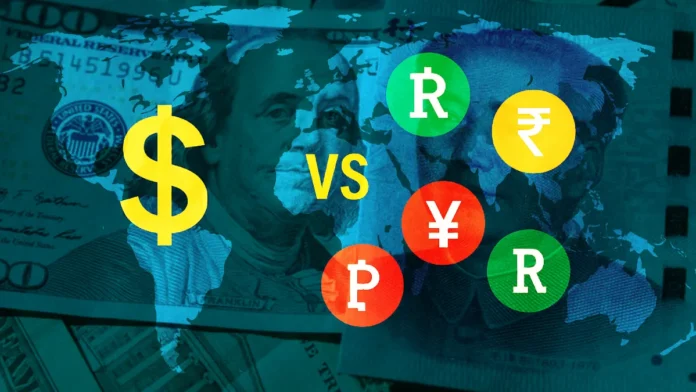For decades, the global financial system has revolved around the U.S. dollar. Since the 1970s, when Washington secured a deal with Saudi Arabia and OPEC to price oil exclusively in dollars, the world has been locked into the “petrodollar system.” This arrangement cemented America’s currency as the backbone of global trade and allowed Washington to wield the dollar as both an economic tool and a geopolitical weapon.
However, in recent years, a counterweight has been quietly emerging. The BRICS bloc (Brazil, Russia, India, China, and South Africa, now expanded to include new members like Saudi Arabia, Egypt, and the UAE) is pushing for an alternative. Their discussions of a shared BRICS currency, or at least greater reliance on local currencies in trade, signal the most serious attempt in decades to move away from dollar dominance.
The shift is underway as the BRICS nations are exploring ways to reduce their dependence on the dollar, including the possibility of a shared currency. Their aim is simple: to create an alternative system less vulnerable to U.S. influence and sanctions.
This development reflects more than economics. It signals a broader move toward multipolarity, a world where no single currency or country dictates the rules. Whether BRICS succeeds or not, the debate itself shows how much the global order is evolving. The age of unquestioned dollar dominance may be giving way to something new.
Before we dig in, let’s first understand the BRICS.
Contents
A Brief History of BRICS
The BRICS grouping was formalized in the late 2000s, originally as “BRIC,” before South Africa joined in 2010. It was envisioned as a coalition of major emerging economies that could serve as a counterweight to Western-dominated institutions like the IMF and World Bank. Over time, BRICS has sought to expand its influence by creating parallel financial structures, including the New Development Bank, and by deepening trade and investment ties among members. With recent expansions to include energy giants and key regional players, the bloc represents an even greater share of global GDP and population.
Resurgence of Multipolarity
What began as an economic bloc has now evolved into a political statement. The expansion of BRICS and its push for monetary independence represent more than technical adjustments; they symbolize the resurgence of multipolarity.
For decades, the U.S.-led unipolar world order shaped global institutions, security alliances, and financial systems. Today, BRICS nations are openly challenging that structure, insisting that global governance should reflect a more diverse and balanced distribution of power.
Multipolarity is not just a buzzword. It is a demand for recognition. The rise of Asia, the assertiveness of resource-rich states, and the frustrations of the Global South with Western double standards have converged into a new momentum that BRICS now embodies.
Why BRICS Countries Are Pushing for an Alternative Currency System?
The push for a BRICS currency or at least greater use of local currencies did not emerge overnight. It was born out of necessity. For decades, BRICS members relied heavily on the U.S. dollar for international trade, exposing them to vulnerabilities that often undermined their sovereignty.
Several key factors drove this shift:
- Weaponization of the Dollar
The U.S. has increasingly used the dollar as a tool of foreign policy. Sanctions against Russia, Iran, and Venezuela froze access to international payments and reserves. For BRICS nations, this highlighted the risk of depending on a system where Washington could unilaterally cut off financial lifelines. - Trade Imbalances and Costs
Conducting trade in dollars forces countries to maintain large reserves, raising costs for import-dependent economies. It also exposes them to exchange rate fluctuations, especially when the Federal Reserve changes interest rates. These ripple effects often destabilize developing markets. - Desire for Economic Sovereignty
A shared or alternative currency represents more than just efficiency; it is about independence. By reducing reliance on the dollar, BRICS nations aim to make their economies less vulnerable to Western financial shocks and political pressures. - The Rise of China and Regional Ambitions
China’s yuan has steadily grown in global use, supported by Beijing’s Belt and Road Initiative and its role as the world’s largest exporter. This gave BRICS a concrete example of how a non-dollar trade system could function. - Energy and Resource Power
With members like Russia, Saudi Arabia, and Brazil commanding vast energy and commodity markets, BRICS countries recognized that they had the leverage to price and settle trade in their currencies, challenging the petrodollar at its core.
In short, BRICS nations realized that the dollar was both a convenience and a chain. To break free, they began pushing for local-currency trade arrangements and discussions of a long-term shared unit of settlement.
BRICS Currency vs the Petrodollar
The dollar still dominates global reserves and oil markets, but the BRICS bloc is actively experimenting with ways to settle trade in local currencies and reduce reliance on U.S. clearing systems. Russia and China, for instance, already conduct the majority of their energy trade outside of the dollar, while India has experimented with rupee-based settlements for oil imports.
The idea of a unified BRICS currency remains distant, hampered by differences in economic policy and trust among members. Yet the symbolism of challenging the petrodollar is powerful. For many nations, breaking free from dollar hegemony means reclaiming autonomy in foreign policy and financial stability.
Why the Dollar Still Dominates
The dollar remains supreme for several reasons. It is deeply entrenched in global trade, financial markets, and central bank reserves. Nearly 60 percent of foreign reserves are still held in dollars, and around 80 percent of global trade is invoiced in it. The U.S. Treasury market provides unmatched liquidity and perceived safety, making the dollar difficult to replace in practice.
Moreover, the dollar underpins the global sanctions regime. Countries that cross Washington’s red lines often find themselves locked out of the dollar system, which can cripple economies. Iran and Russia are the clearest examples. This “weaponization of finance” has accelerated calls for alternatives.
Obstacles to a BRICS Currency
Despite all the talk, there are still many practical hurdles. BRICS countries have very different economies, political systems, and long-term goals. Building a shared currency would mean agreeing on one monetary policy, creating strong common institutions, and setting up systems of trust. These are not easy tasks. The European Union itself took decades to achieve this kind of financial integration. Even trading in local currencies comes with problems, such as unstable exchange rates and the fact that many of these currencies cannot be easily used outside their home countries.
The push for alternatives is gaining energy, but the path forward is uneven. Each BRICS member has its priorities. China wants to expand the use of the yuan worldwide, while India does not want to depend too heavily on Beijing. Russia is eager to escape the grip of U.S. sanctions, but Brazil remains cautious about straining ties with Western markets. On top of this, creating a shared system would demand major coordination in monetary policy, financial regulation, and payment infrastructure. For now, such deep cooperation appears unlikely.
The dollar also has an advantage that goes beyond oil pricing. It is trusted. Investors continue to see U.S. financial markets as the safest and most reliable in the world. Until BRICS members can build institutions that inspire the same level of confidence, it will be very hard to move the dollar away from the center of global finance.
Conclusion
The petrodollar system gave the U.S. unparalleled economic power for half a century. Now, the BRICS bloc is pushing back, envisioning a financial system where multiple centers of power exist. Whether or not a BRICS currency materializes, the very fact that such alternatives are being seriously pursued marks a turning point. The world may be entering an era where the dollar is still important, but no longer unchallenged.
Also Read: The Petrodollar System: How the U.S. Dollar Became the Geopolitical Weapon
Sources
- Council on Foreign Relations. “What Is the BRICS Group and Why Is It Expanding?” CFR.org, 2025.
- Reuters. “What is BRICS, which countries want to join, and why?” Reuters, 21 Aug. 2023.
- Goldman Sachs. “With GS Research Report, ‘BRICs’ Are Born.” 2001.
- European Parliamentary Research Service. “Expansion of BRICS: A Quest for Greater Global Influence?” EPRS, 2024.
- Pistilli, Melissa. “How Would a New BRICS Currency Affect the US Dollar?” InvestingNews.com, 22 July 2025.
- “BRICS Pay.” Wikipedia, updated recently. Web.
- John Zadeh. “BRICS Currency and Multipolarity: Challenging Dollar Dominance in 2025.” DiscoveryAlert.com.au, 1 Aug. 2025.
- GreentechCentral Banking. “BRICS Group Highlights Currency Risk in Climate Strategy.” 18 July 2025.
- The Guardian. “Trust in the US Is Eroding. The Question Isn’t If the Dollar Will Lose Supremacy – It’s When.” The Guardian, 16 July 2025.
- Politico. “Trump’s BRICS-Fueled Anger Sparked 50 Percent Tariff Threat on Brazil.” Politico, 10 July 2025.
- Business Insider. “Trump Is Targeting a Group of Countries over ‘Anti-American’ Policies.” BusinessInsider.com, 2025.
FACT CHECK: We strive for accuracy and fairness. But if you see something that doesn’t look right, please Contact us.
DISCLOSURE: This Article may contain affiliate links and Sponsored ads, to know more please read our Privacy Policy.
Stay Updated: Follow our WhatsApp Channel and Telegram Channel.












